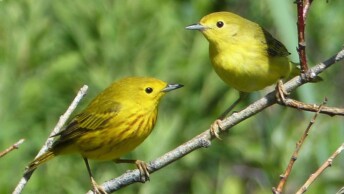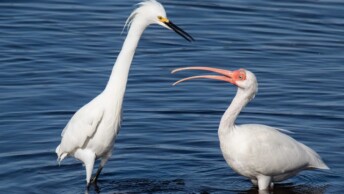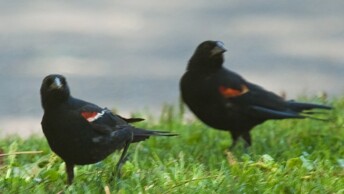Across North America’s wetlands, coastlines, and open fields, many brown-plumaged birds share one defining feature – noticeably long bills suited to their feeding style. Among them are waders and marsh birds that probe soft mud and shallow water, as well as smaller songbirds that use their slender beaks to search for insects among leaves and branches.
This guide highlights the main brown birds with long beaks found across the United States and Canada, focusing on their key identification features, behaviors, and habitats. It also points out the subtle differences that help tell these often similar-looking species apart in the field.
Wilson’s Snipe
Gallinago delicata
- Identification: Medium-sized, brown-and-buff shorebird with a very long straight bill, short legs, and intricate striping on the head and back. The underparts are white with heavy brown streaking on the breast and flanks.
- Where found: Breeds widely across North America in marshes, bogs, wet meadows, and tundra. Winters south through the southern U.S., Mexico, Central America, and the Caribbean.
- How to spot: Usually hidden in wet vegetation and flushed at close range, flying off in a rapid, zigzag pattern while calling a harsh “scaap.” During spring displays, males perform aerial dives producing the tremulous “winnowing” sound with their tail feathers.
- Conservation status: Least Concern (IUCN); populations are stable overall, though local declines occur with wetland drainage and habitat loss.
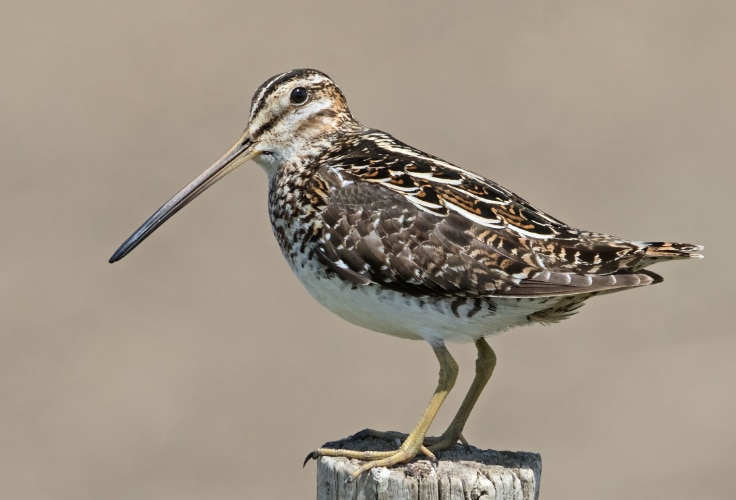
The Wilson’s snipe is one of North America’s most widespread brown birds with a long beak, a secretive inhabitant of bogs and wet meadows. Measuring 27-32 centimeters (10.6-12.6 inches) in length, it has a short, plump body and a remarkably long, straight bill several times the length of its head. Its plumage is an intricate mosaic of brown, black, and buffy markings that blend perfectly with marsh vegetation. Pale longitudinal stripes run down the crown and back, while the underparts are white with dense brown spotting on the breast and sides. The tail shows a rusty hue when the bird takes flight, contrasting with otherwise dark, unpatterned wings.
Though often unseen, the Wilson’s snipe is full of life and sound. When flushed, it bursts from cover in an erratic, twisting flight, uttering a sharp, rasping “scaap.” During courtship, males rise high into the air before diving to produce a haunting tremolo known as “winnowing,” created by air rushing through their spread tail feathers. On the ground, they move with quick steps through wet soil, probing deeply with flexible bills to detect worms and insect larvae by touch. The birds often perch on fence posts or low branches, especially during the breeding season, and feed most actively at dawn and dusk.
This species breeds throughout much of North America, from Alaska and northern Canada south through the northern United States and parts of the interior West. In winter, it withdraws from frozen northern wetlands to milder regions across the southern U.S., Mexico, Central America, and the Caribbean. Although once heavily hunted, the Wilson’s snipe remains common and adaptable, thriving wherever shallow, soft-soiled wetlands persist. Continued conservation of bogs and marshes will be vital to sustaining its populations across the continent.
American Woodcock
Scolopax minor
- Identification: Compact, plump shorebird with a very long straight bill, large rounded head, and no visible neck. Plumage is mottled in brown, buff, and gray. The eyes are large and set far back on the head.
- Where found: Widespread across eastern North America; breeds in young forests, shrubby fields, and forest edges north to southern Canada; winters mainly in the southeastern U.S. and along the Gulf Coast.
- How to spot: Most easily located at dawn or dusk in spring when males give nasal “peent” calls and spiral upward in dramatic displays, producing twittering sounds with their wings. On the ground, look for slow, rocking walks and probing behavior with the long bill.
- Conservation status: Least Concern (IUCN); populations have declined with forest succession and habitat loss, but targeted management of young forests supports local recovery.
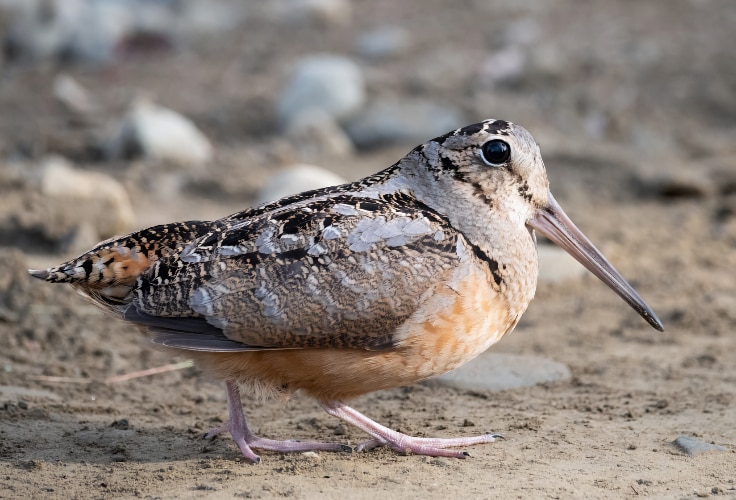
The American woodcock is one of the most distinctive brown long-billed birds in North America, a woodland counterpart to the open-country snipe. Measuring 25-31 centimeters (9.8-12.2 inches) in length, it is short-legged and compact, with a large head, broad wings, and a bill nearly one-fourth its total length. Its plumage, a finely mottled pattern of warm browns, buffs, and grays, provides excellent camouflage against fallen leaves. The eyes sit high and far back on the head, giving a wide rearward field of vision – ideal for detecting predators while probing the soil for worms.
On the ground, woodcocks move with slow, deliberate steps and a peculiar rocking motion as they probe soft soil with flexible bills. They feed mostly on earthworms, using sensitive bill tips to detect movement beneath the surface and extract prey with delicate precision. During the breeding season, the male’s crepuscular courtship displays are among the most spectacular of any North American bird. From an open singing ground, he gives a series of loud, nasal “peent” calls before taking off in a spiraling flight high into the air, where his wings produce a musical twittering sound. As he descends, he gives soft chirps before landing to resume his rhythmic calls.
The species breeds widely through forested and mixed farmlands east of the Great Plains, from southern Canada to the central and northeastern United States. It winters mostly across the southeastern states, the Gulf Coast, and occasionally as far north as New Jersey and Massachusetts during mild years. Populations have declined gradually due to loss of young forest and shrubland habitats caused by natural forest succession and development. However, where early successional forests are maintained, the American woodcock remains a familiar voice of spring twilights across eastern North America.
Greater Yellowlegs
Tringa melanoleuca
- Identification: Tall, long-legged shorebird with a slender neck, straight dark bill, and bright yellow legs. Plumage dark brown above with pale spotting and white underparts marked by variable streaking and barring.
- Where found: Breeds in boreal wetlands across central Canada and southern Alaska; widespread migrant and winter visitor throughout most of North America.
- How to spot: Often solitary or in small groups, wading in deeper water than most sandpipers. Moves with quick, deliberate steps and gives clear, ringing “tew-tew-tew” calls when flushed or in flight.
- Conservation status: Near Threatened (IUCN); populations remain stable but depend on intact wetlands and are still affected by hunting in parts of the Caribbean.

The greater yellowlegs is one of the most widespread brownish shorebirds in North America, instantly recognizable by its bright yellow legs and sleek proportions. Measuring 29-33 centimeters (11.4-13 inches) in length, it stands tall with a slender neck and a long, dark bill slightly upturned toward the tip. Its plumage is patterned in brown, gray, and white, creating a checkered appearance on the back and wings. The head and neck show dark streaks, while the underparts are white with variable barring and speckling. In flight, a square white rump and dark wings form a sharp contrast visible from afar.
In the field, the species’ alert posture and vivid legs make it easy to spot, even at a distance. It wades confidently through deeper water than most other sandpipers, moving with brisk, high-stepping strides and often feeding by rapid probing or side-sweeping motions. The long bill is used to seize small fish, aquatic insects, crustaceans, and amphibians. Its calls – clear, ringing “tew-tew-tew” notes, serve as both contact and alarm signals, often given as the bird flushes and flies off on strong, steady wings.
The greater yellowlegs breeds in the bogs, muskeg, and wet coniferous forests of central Canada and southern Alaska, nesting near shallow pools and mossy openings. During migration, it frequents mudflats, flooded fields, and the margins of lakes and reservoirs across the continent. In winter, it is found in coastal and inland wetlands throughout the southern United States, Mexico, Central America, and the Caribbean. Though still common, it depends heavily on wetland conservation, as habitat loss and continued hunting pressure in parts of its range remain significant concerns.
Lesser Yellowlegs
Tringa flavipes
- Identification: Slender, medium-sized shorebird with long yellow legs, slim neck, and straight, dark bill. Plumage gray-brown above with fine white spotting, and white below with light gray streaking on the neck and breast.
- Where found: Breeds in the boreal forest zone across Alaska and Canada. Seen throughout North America during migration and winters along the southern U.S. coasts, Mexico, Central America, the Caribbean, and South America.
- How to spot: Smaller and daintier than the greater yellowlegs, with a shorter, straighter bill. Walks with a quick, high-stepping gait through shallow water, feeding by rapid pecking and short probes. Gives clear, sharp “tu” or “whew” calls when flushed or alarmed.
- Conservation status: Vulnerable (IUCN); populations have declined steeply due to wetland loss and continued hunting pressure in parts of the Caribbean.
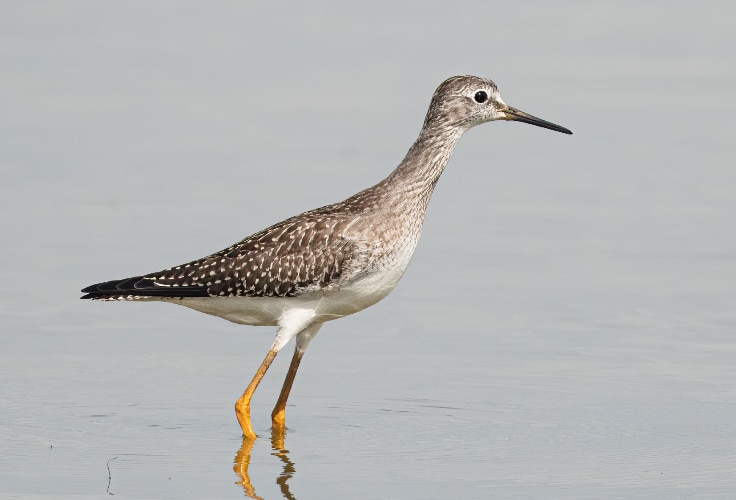
The lesser yellowlegs is a graceful shorebird with a long, fine bill and bright yellow legs. Measuring 23-27 centimeters (9.1-10.6 inches) in length, it is smaller and slimmer than the greater yellowlegs, with a straight, needlelike bill only slightly longer than the head. Its upperparts are grayish brown with neat white spotting, while the underparts are mostly white with fine streaking on the neck and chest. The head shows a pale eyering and delicate gray mottling that gives the bird a refined, alert appearance. Its overall look is elegant and clean, accentuated by the bright yellow legs that flash in flight or when wading in shallow pools.
This species is an active and agile forager, moving briskly through shallow water with quick, high-stepping strides. It picks small aquatic invertebrates and insects from the surface or mud, occasionally probing or snapping up prey midair. The lesser yellowlegs often feeds alone or in small loose groups, though flocks gather at rich stopover sites during migration. Its calls are clear, whistled “tu” or “whew notes” – softer and fewer in sequence than those of the greater yellowlegs. In flight it appears light and buoyant, with long yellow legs trailing behind the tail and wings showing no bold markings.
Breeding occurs across the northern boreal forests and muskeg of Alaska and Canada, often in more vegetated and drier habitats than those used by the Greater Yellowlegs. Nests are placed near ponds or open meadows with scattered shrubs and conifers. During migration, the species spreads widely across North America, using shallow wetlands, flooded fields, and exposed mudflats. It winters mainly along the Gulf Coast, Central America, the Caribbean, and as far south as southern South America. Once heavily hunted, the lesser yellowlegs has rebounded but now faces sharp declines linked to wetland degradation and ongoing hunting on some Caribbean islands.
Short-Billed Dowitcher
Limnodromus griseus
- Identification: Medium-sized, chunky shorebird with a long straight bill and rich orange- or cinnamon-toned underparts in breeding plumage. Upperparts patterned in brown, black, and gold; tail barred black and white.
- Where found: Breeds in boreal wetlands near the treeline across Canada and Alaska; migrates widely through North America, wintering along both coasts, the Gulf of Mexico, the Caribbean, and Central America.
- How to spot: Often found probing rhythmically in shallow mud or tidal flats with “sewing machine” precision. Listen for soft, musical “tu-tu-tu” calls. Frequently seen in flocks during migration and winter.
- Conservation status: Vulnerable (IUCN); populations have declined by more than half in 50 years due to habitat loss, coastal development, and hunting pressure on wintering grounds.
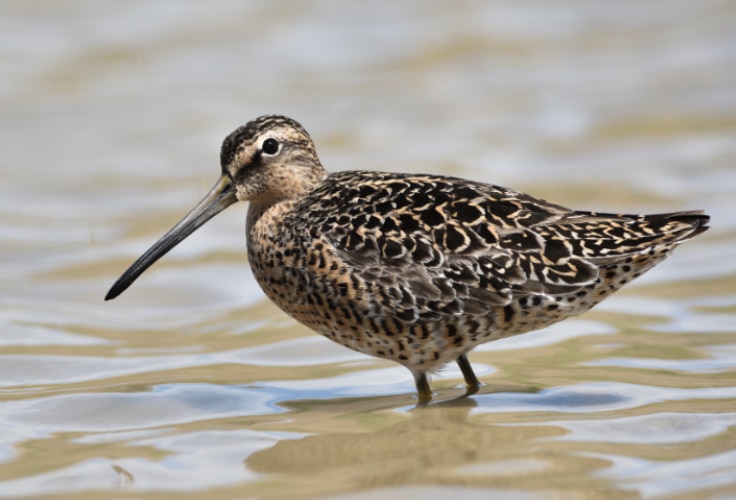
The short-billed dowitcher is a striking brown shorebird whose name hardly does justice to its impressive bill length. Measuring 25-29 centimeters (9.8-11.4 inches), it has a compact body, long legs, and a straight, sturdy bill used for deep probing in mud and sand. In breeding plumage, it shows rich orange or rusty tones on the breast and belly, finely barred and spotted with brown, while the back shimmers with dark and golden markings. The tail is boldly barred black and white. Outside the breeding season, adults become plain gray-brown above and pale below, with only faint streaking on the breast.
In the field, short-billed dowitchers are energetic foragers, moving in shallow wetlands and coastal flats with rapid, vertical bill motions that resemble a sewing machine in action. They feed on aquatic invertebrates, worms, crustaceans, and insects, often working side by side in tight groups. During migration and winter, they roost communally at high tide and feed actively during low tide or in flooded fields. On the breeding grounds, males perform fluttering flight displays over the tundra, accompanied by a bubbly, musical song that carries across the wetlands. Their soft “tu-tu-tu” flight calls help distinguish them from the closely related long-billed dowitcher, which gives sharper, higher-pitched notes.
This species breeds in muskegs and sedge meadows across the subarctic and boreal zones of Canada and coastal Alaska, nesting near pools and thawing bogs. During migration it occurs almost anywhere with shallow water – tidal flats, salt marshes, freshwater ponds, flooded fields, and even sewage lagoons. In winter it ranges widely along both North American coasts, south through the Caribbean and Central America to northern South America. Once abundant, the short-billed dowitcher has suffered serious population declines from hunting, coastal development, and wetland loss. Climate-driven changes to its breeding habitats and sea-level rise in wintering areas pose new threats, making continued wetland protection essential for its survival.
Long-Billed Dowitcher
Limnodromus scolopaceus
- Identification: Medium-sized, plump shorebird with a very long, straight bill and compact body. Breeding adults show rich rufous and black patterning with barred underparts; non-breeding birds are plain gray-brown above and pale below.
- Where found: Breeds in wet sedge meadows and tundra pools across western and northern Alaska and eastern Siberia. Migrates widely through North America, wintering mainly in freshwater wetlands across the southern U.S., Mexico, and Central America.
- How to spot: Feeds in shallow freshwater habitats, probing rapidly with “sewing machine” motions. Listen for the distinctive sharp “keek!” call.
- Conservation status: Near Threatened (IUCN); populations have declined steeply due to wetland loss, pollution, and climate-driven habitat change.
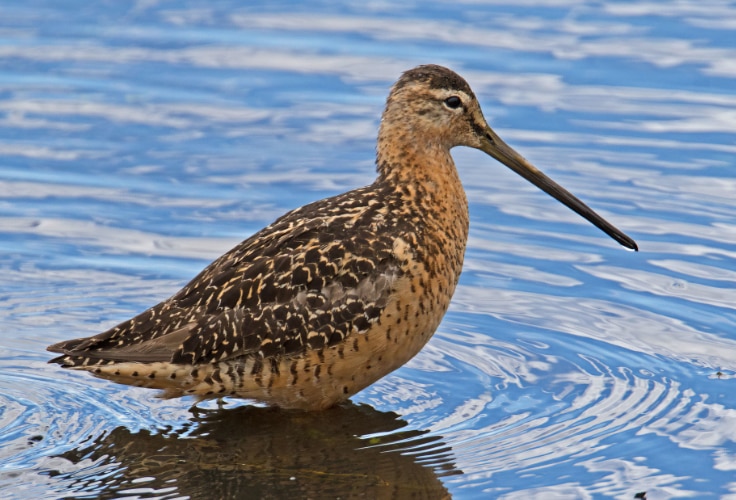
The long-billed dowitcher is a stout, long-billed brown shorebird that thrives in shallow wetlands and tundra pools. Measuring about 29 centimeters (11.4 inches) in length, it has a straight, elongated bill used for deep probing, a short tail, and relatively long yellowish legs. In breeding plumage, its back is richly patterned with black, rufous, and buff, while the underparts glow deep reddish-brown, densely barred with black. Outside the breeding season, the plumage turns subdued gray-brown above and pale below, blending perfectly with the muddy wetlands it frequents.
These dowitchers are most often recognized by behavior and voice rather than appearance. They feed by rhythmically plunging their bills straight down into soft mud, moving methodically across the shallows with astonishing speed and precision, earning the nickname “sewing machine” among birders. Flocks often keep up a low, twittering chatter while foraging, punctuated by the sharp, ringing “keek!” that distinguishes this species from the short-billed dowitcher. During the Arctic breeding season, males perform buoyant song flights with melodious, rippling calls over the tundra. They feed mainly on aquatic invertebrates such as worms, snails, and small crustaceans, probing by touch with sensitive nerve endings at the bill tip.
Long-billed dowitchers breed across the tundra lowlands and foothills of northern and western Alaska and extends into eastern Siberia. During migration they use an extensive network of freshwater wetlands across interior North America – marshes, flooded fields, ponds, and sewage treatment lagoons, rarely venturing into saltwater habitats. The species winters from the southern United States through Mexico and Central America, occasionally reaching northern South America. Once abundant across the West, the long-billed dowitcher has suffered sharp declines as a result of widespread wetland drainage, agricultural conversion, and the effects of pollution and climate change on its Arctic and inland wetland habitats.
Marbled Godwit
Limosa fedoa
- Identification: Large, long-legged shorebird with a very long bill and warm cinnamon tones throughout the plumage. Upperparts and flanks are finely barred, and the underwings glow rich orange-cinnamon in flight.
- Where found: Breeds in the northern Great Plains of the U.S. and southern Canada; winters mainly along the Pacific, Gulf, and southeastern Atlantic coasts from California and Texas south through Mexico and Central America.
- How to spot: Often seen foraging in shallow water or on mudflats, probing deeply with its long bill. In flight, shows bright cinnamon wings and trailing legs that extend beyond the tail. Forms loose flocks along coastal estuaries and tidal flats in winter.
- Conservation status: Vulnerable (IUCN); populations stable but range-restricted and vulnerable to prairie habitat loss and wetland degradation.

The marbled godwit is among North America’s most striking brown shorebirds, combining large size, rich cinnamon tones, and a long, slightly upturned bill. Measuring 42-48 centimeters (16.5-18.9 inches) in length, it has long gray legs, a slender neck, and a distinctive two-toned bill – pinkish or orange at the base and dark toward the tip. Its plumage is mottled in browns and buffs, creating a marbled appearance, with barred flanks and bright cinnamon underwings visible in flight.
On the breeding grounds, marbled godwits walk gracefully through open grasslands and shallow wetlands, probing soft soil for insects, worms, and aquatic tubers. Along coastal mudflats and estuaries in migration and winter, they feed in shallow water, plunging their long bills deep into sand or mud to extract polychaete worms, small crabs, or bivalves. They are often seen in small groups, their tall posture and warm plumage making them stand out among other shorebirds. In flight, their long legs extend beyond the tail and the underwings flash a deep cinnamon hue. Their calls are nasal and ringing – sharp “whit-whit” or “cor-ack” notes often heard over tidal flats or breeding meadows.
This species breeds primarily in the northern prairies of the United States and southern Canada, from Alberta and Saskatchewan to the Dakotas and Montana, with small isolated populations in Alaska and along James Bay. After breeding, godwits migrate south to winter along the Pacific coast from California through Mexico to Central America, and along the Gulf and southern Atlantic coasts of the U.S. Although the global population is stable, the species is confined to a limited breeding range and remains sensitive to loss of native prairie and wetland habitats. Protection of these grassland-wetland mosaics is key to securing the future of this elegant prairie shorebird.
Long-Billed Curlew
Numenius americanus
- Identification: Very large, long-legged shorebird with an extremely long bill, buff and cinnamon tones across body, and speckled brown upperparts.
- Where found: Breeds in open grasslands of the Great Plains, Great Basin, and western interior Canada; winters mainly along southern U.S. coasts, Mexico, and Central America.
- How to spot: Look for tall, buff-brown birds striding through short grass or mudflats, probing deeply with their long bills. In flight, note the cinnamon underwings and distinctive “curlee” whistle.
- Conservation status: Least Concern (IUCN); populations stable but still limited by grassland loss and wetland degradation.

The long-billed curlew is North America’s largest shorebird, instantly recognizable by its long, thin, downcurved bill and warm buff plumage. Measuring 50-65 centimeters (19.7-25.6 inches) in length, it has long legs, a slender neck, and a small head that accentuates the remarkable bill length, especially in females. Its body is washed with cinnamon and speckled brown on the back, while the underwings glow rich orange-cinnamon in flight. The pale face, streaked neck, and pinkish bill base add contrast to the otherwise earth-toned plumage.
These curlews are graceful yet alert in the field, often seen walking briskly through open grasslands or tidal flats, probing deeply for insects, crustaceans, and worms. On their breeding grounds, they feed largely on grasshoppers, switching to shrimp and crabs in winter coastal habitats. When flushed, they rise on steady, strong wingbeats, calling a clear, whistled “curlee” that carries far across the prairie. In flight, their long bill and bowed wings create a unique silhouette. They often forage in pairs or small groups, occasionally associating with willets and marbled godwits during migration. The whimbrel is the only similar species, but it appears darker, smaller, and lacks the curlew’s warm cinnamon tones.
Breeding across the shortgrass and mixed-grass prairies of the Great Plains, Great Basin, and southern interior of British Columbia, the long-billed curlew favors open, treeless expanses with low vegetation that allow clear sightlines for predator detection. After nesting, adults and fledglings move to wetter pastures and fields before migrating to wintering grounds along the coasts of California, Texas, Louisiana, and Mexico, with smaller numbers along the Pacific Northwest and Gulf of California. Once much more widespread, the species disappeared from much of its eastern range by the early 1900s due to hunting and conversion of prairie habitat to farmland. Today its populations are locally stable but still face ongoing threats from agricultural expansion, pesticide use, and climate-driven habitat loss.
Whimbrel
Numenius phaeopus
- Identification: Large, long-legged shorebird with a long bill and mottled brown plumage. Shows dark crown stripes with a pale central line and bold whitish eyebrow. Underparts buff with fine streaks and barring.
- Where found: Breeds across northern Alaska and Canada on tundra and open bogs. Seen during migration along both North American coasts, and winters mainly in coastal South America, the Caribbean, and parts of Central America.
- How to spot: Often on mudflats, beaches, and saltmarshes, walking steadily and probing for crabs with its long, curved bill. Listen for its distinctive, bubbling whistles or mellow “cur-lee” calls.
- Conservation status: Least Concern (IUCN); populations have declined significantly in recent decades due to habitat loss and continued hunting on some wintering grounds.
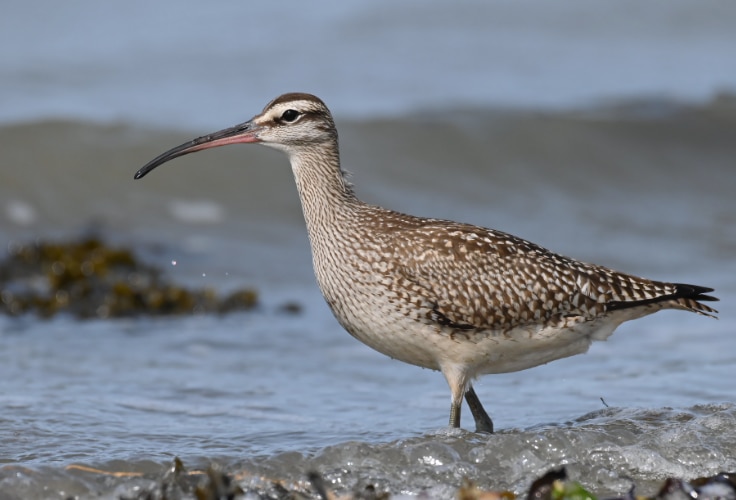
The whimbrel is one of most recognizable brown shorebirds with a long, strongly curved bill – a classic silhouette of coastal mudflats and tundra plains. Measuring 43-46 centimeters (16.9-18.1 inches) in length, it is smaller than a curlew but still robust and long-winged. Its upperparts are dark brown with buff mottling, blending perfectly with wet tundra and beach sand. The head pattern is striking, with dark crown stripes framing a pale central line and a distinct whitish supercilium over the eye. The underparts are buff with dark streaks across the breast, fading to paler tones toward the belly.
In the field, whimbrels are active yet composed, striding through mudflats and saltmarshes with a steady gait. They feed mainly on crabs, mollusks, and marine worms, deftly extracting prey from burrows with precise, flexible bill movements. During migration and on breeding grounds, they also eat insects, berries, and occasionally seeds. Their voice – a mellow “cur-lee” or a rapid, rippling series of whistles, often reveals their presence before they are seen. Whimbrels fly strongly on long, pointed wings, sometimes in loose formations over open water, and glide smoothly when approaching feeding sites. When alarmed, they give far-carrying, whistled calls that rise and fall musically across tidal flats.
This species breeds in the far north, on open tundra and mossy uplands of Alaska and northern Canada, nesting among sedges and low shrubs. During migration, Whimbrels move along both coasts of North America, favoring tidal flats, beaches, and salt marshes. Many winter in the Caribbean, Central America, and especially along the coasts of South America, from Colombia to Chile and Argentina. Historically, whimbrels were heavily hunted across North America and remain targeted in parts of the Caribbean and South America. Coastal development, wetland loss, and rising sea levels further threaten their key habitats.
Virginia Rail
Rallus limicola
- Identification: Small, reddish-brown marsh bird with a long bill, gray cheeks, and black-and-white barred flanks. Tail often held upright, revealing white undertail feathers.
- Where found: Breeds locally across much of North America in freshwater and brackish marshes with cattails and bulrushes; winters mainly along the coasts and in southern interior wetlands from the U.S. into Mexico.
- How to spot: Usually heard before seen – listen for paired grunting calls in spring. Active at dawn and dusk, creeping through reeds or briefly crossing open mudflats. When flushed, flies weakly with dangling legs before dropping back into cover.
- Conservation status: Least Concern (IUCN); populations appear stable overall, though continued wetland loss poses local risks.

The Virginia rail is one of the most characteristic brown birds of North American wetlands – a secretive, slender inhabitant of dense freshwater marshes. Measuring 22-27 centimeters (8.7-10.6 inches) in length, it has a laterally compressed body, a long, slightly downcurved reddish bill, gray cheeks, warm brown body, and fine black-and-white barring along the flanks. The wings are chestnut, and the tail is short and often cocked upward, flashing white undertail coverts as the bird walks. Its long toes help it balance on floating vegetation, while its flexible spine allows it to slip effortlessly between reeds.
Despite its elusive nature, this rail can be surprisingly vocal. Its most familiar sound is a series of paired grunts – “kidick-kidick-kidick,” given by both members of a pair during the breeding season. Less frequent calls include sharp “kiu” notes and a brief “kicker” call in spring. When startled, it may dash through cattails or take a short, fluttering flight with dangling legs before dropping back into cover. The Virginia rail forages methodically along shallow water and mudflats, probing with its slightly decurved bill for insects, crustaceans, and worms, often at dawn and dusk. Its slow movements, flicking tail, and reddish bill often betray its presence.
Breeding across much of temperate North America, from southern Canada and the northern United States to parts of the interior West and Mexico, the Virginia rail inhabits marshes with shallow water and dense emergent vegetation. Northern populations migrate southward for winter, concentrating along the Atlantic, Pacific, and Gulf coasts and in interior wetlands where the water remains unfrozen. Though seldom seen, this adaptable little rail remains widespread and locally common, a year-round resident of healthy wetlands and a true symbol of life hidden within the reeds.
American Bittern
Botaurus lentiginosus
- Identification: Medium-sized, brown heron with a stout body, thick neck, and long, pointed bill. Plumage streaked in brown and buff, with a black line down each side of the neck.
- Where found: Breeds widely across northern and central North America in freshwater marshes with tall vegetation; winters mainly along the southern coasts, in the Gulf region, Florida, and southern California.
- How to spot: Best detected by its deep, booming “pump-er-lunk” calls in spring. Usually seen standing motionless among reeds, neck stretched and bill pointed upward in a “freeze” posture. Flies low and heavily, dropping quickly back into cover.
- Conservation status: Least Concern (IUCN); widespread but declining in parts of its range due to wetland loss and degradation.
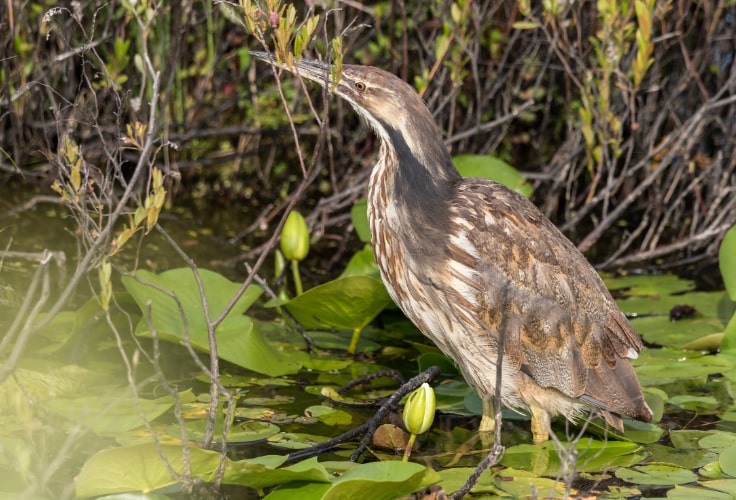
The American bittern is one of North America’s most secretive brown birds with a long beak – a marsh-dwelling heron perfectly adapted to disappear among reeds. Measuring 60-85 centimeters (23.6-33.5 inches) in length, it has a thick, compact body, a strong neck, and relatively short legs for a heron. Its plumage is a complex pattern of brown, buff, and white streaks that blends seamlessly with cattails and sedges. A distinctive black line runs down each side of the neck, and the daggerlike bill is held upright when the bird adopts its classic camouflage stance. The dark flight feathers contrast with the rest of the plumage, making the species easier to identify in flight than at rest.
This solitary hunter moves slowly through marsh vegetation, relying on stealth rather than speed. It feeds mainly on fish, frogs, insects, and small mammals, striking quickly after long, motionless pauses. When alarmed, it points its bill skyward, aligning its streaked body with surrounding stems. During the breeding season, males broadcast deep, resonant “pump-er-lunk” calls that echo across wetlands at dawn and dusk – a sound once thought to come from mythical swamp creatures. Though capable of flight, the species is heavy-winged and prefers to walk or freeze in place, disappearing into vegetation rather than flushing.
The American bittern breeds across most of Canada and the northern United States, favoring freshwater marshes with tall emergent plants such as cattails and bulrushes. It winters in milder regions, particularly the Gulf Coast, southern Atlantic coast, and California wetlands, occasionally reaching the Caribbean. While still widespread, it has declined locally with the drainage, development, and pollution of inland wetlands. Because this species depends on healthy marsh ecosystems throughout its life cycle, the preservation of large, undisturbed wetland complexes remains crucial to its long-term survival.
White-Faced Ibis
Plegadis chihi
- Identification: Medium-sized wading bird with long legs, neck, and curved bill. Appears dark at a distance, but up close shows glossy maroon and bronze plumage with green iridescence. Breeding adults have a thin white line bordering the reddish facial skin.
- Where found: Breeds locally across the interior West and southern Great Plains of North America, from Oregon and the Dakotas south through the Southwest and Mexico; winters mainly along the Gulf Coast, in southern California, and Mexico.
- How to spot: Often in flocks foraging in shallow wetlands and flooded farm fields, especially alfalfa. Watch for birds probing soil or wading through water at dawn or dusk, and for flocks flying in V-formation between roosting and feeding sites.
- Conservation status: Least Concern (IUCN); populations have expanded and increased, though pollution, water diversion, and habitat disturbance continue to threaten local colonies.
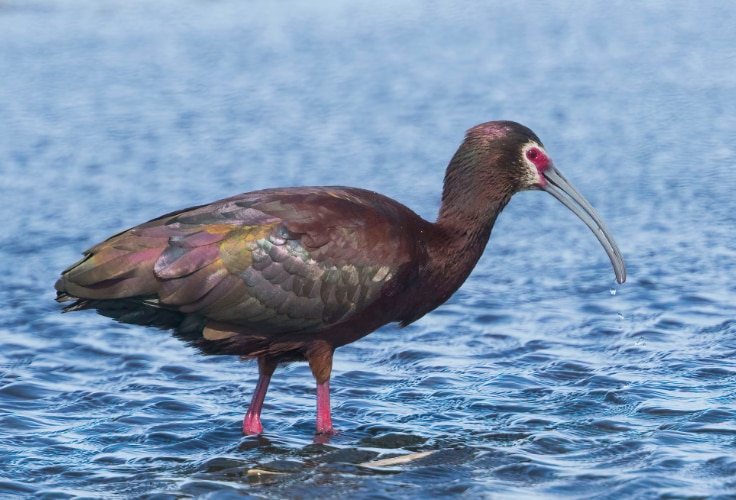
The white-faced Ibis is one of the most striking brownish waders on the continent, its plumage shimmering with metallic greens, purples, and bronzes in good light. Measuring 46-56 centimeters (18.1-22 inches) in length, it has a long, curved bill, slender neck, and blackish legs and toes. Breeding adults display a reddish face and eyes framed by a sharp white outline – features that distinguish them from the similar glossy ibis. In flight, they show broad, rounded wings with a purplish gloss, and often travel in tight, synchronized formations over marshlands and irrigated fields.
These ibises are social foragers, feeding in shallow wetlands and flooded agricultural fields, particularly alfalfa. They probe soft soil and muddy water with their curved bills, locating prey such as insects, earthworms, crayfish, and aquatic larvae. Birds often move together through foraging areas, “leapfrogging” forward as the group advances. After feeding, they gather in colonies within freshwater marshes or on islands of emergent vegetation, nesting close to one another. Their calls are soft and guttural, carrying low over the marsh, while flight displays often include circling or gliding together on thermals.
The species breeds mainly in the interior West, from California, Oregon, Idaho, and the Dakotas south through Utah, Nevada, and Texas, and into central Mexico, with scattered colonies farther south in the Americas. Northern populations migrate to winter in coastal Louisiana and Texas, southern California, and Mexico. Once locally declining due to wetland drainage, the white-faced ibis has rebounded in recent decades, aided by wetland restoration and adaptation to agricultural landscapes. Yet its dependence on stable water conditions and sensitivity to contaminants make ongoing wetland protection vital to its continued success.
Glossy Ibis
Plegadis falcinellus
- Identification: Medium-sized wading bird with a long bill, long legs, and compact body. Appears dark at a distance but in good light reveals deep maroon plumage with metallic green, bronze, and violet gloss.
- Where found: Widely distributed across the world’s warmer regions, including coastal and inland wetlands of the southeastern and mid-Atlantic United States, the Caribbean, Central and South America, southern Europe, Africa, Asia, and Australia.
- How to spot: Search shallow wetlands, flooded fields, or marshes for flocks of dark waders moving slowly and probing mud with their bills.
- Conservation status: Least Concern (IUCN); global populations are large and increasing, though local threats include wetland drainage, pollution, and human disturbance.

The glossy ibis is an elegant and widespread dark-plumaged wader whose subtle brilliance appears only in good light, when its chestnut and metallic plumage gleams with green, bronze, and violet hues. Measuring 48-66 centimeters (18.9-26 inches) in length, it has a long neck, slender body, and long, decurved bill suited to probing mud and shallow water for aquatic invertebrates and small prey. During the breeding season, the facial skin turns blue-black with a narrow pale-blue border above and below the eye, remaining faintly visible year-round.
These birds are gregarious feeders, often foraging in flocks across shallow freshwater, brackish, and saltwater wetlands, rice fields, or flooded grasslands. They probe and sweep their bills side to side to locate aquatic insects, worms, mollusks, and crustaceans, sometimes feeding alongside herons, egrets, and spoonbills. When nesting, glossy ibises form colonies in dense marshes or shrubs, often some distance from feeding areas, and commute in V-formations or loose skeins with necks and legs outstretched.
In North America, the species breeds locally along the Atlantic and Gulf coasts from Maine and New Jersey south to Florida and Louisiana, with additional colonies in the Caribbean, Mexico, and Central America. Outside the Americas, it ranges widely across southern Europe, Africa, Asia, and Australia. Though populations have expanded rapidly in the past century, continued protection of wetlands and reduction of pollutants remain essential to ensure the persistence of this globally dispersed and increasingly common ibis.
Brown Thrasher
Toxostoma rufum
- Identification: Large, slender songbird with rich rufous-brown upperparts, long tail, yellow eyes, and boldly streaked whitish underparts. Shows two distinct whitish wingbars and a long bill.
- Where found: Common in central and eastern North America, inhabiting dense thickets, hedgerows, and woodland edges from southern Canada to the Gulf Coast.
- How to spot: Watch for a reddish-brown bird darting into brush or flipping leaves on the ground; listen for a loud, musical song with paired phrases, usually sung from an exposed perch.
- Conservation status: Least Concern (IUCN); populations declining moderately due to habitat loss, fragmentation, and collisions during migration.
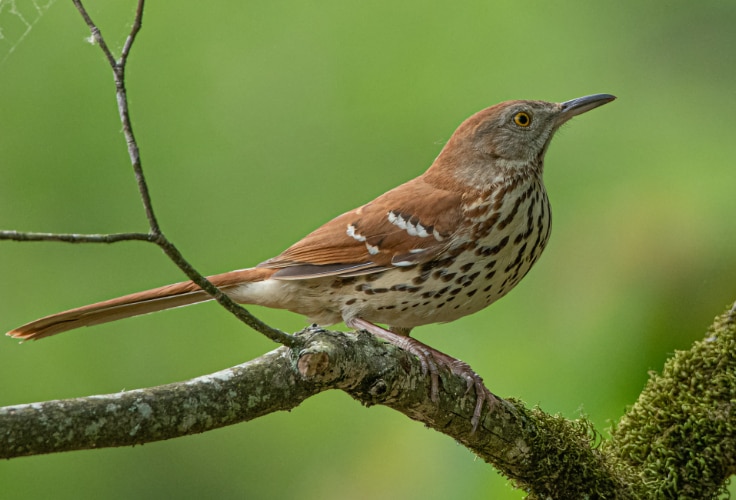
The brown thrasher is the only thrasher species found east of Texas and one of North America’s most striking brown songbirds. Measuring 23-30 centimeters (9.1-11.8 inches) in length, it has a long, rufous tail, strong legs, and a long, slightly curved bill. Its plumage is vivid reddish-brown above, with a pale underside boldly streaked in dark brown, and its intense yellow eyes give it a fierce expression. The wings show two pale bars that stand out even in dim light. Despite its bright coloration, this species remains elusive, slipping quickly into dense cover when disturbed.
Brown thrashers are energetic and accomplished singers, capable of producing more than 1,100 different song types – one of the largest repertoires of any North American bird. Their rich, melodious song resembles that of the northern mockingbird but is more musical and typically repeats each phrase twice rather than three times. Males sing from exposed perches high in shrubs or small trees, particularly during spring and early summer. On the ground, the thrasher forages by sweeping its bill side to side through leaf litter, noisily uncovering beetles, caterpillars, and other insects, and later in the year, berries and seeds. When alarmed, it drops low and runs for cover, tail flicking and wings partially spread, occasionally giving sharp “tchuck” or “smack” calls.
This species breeds widely across central and eastern North America, from southern Canada to Florida and the Gulf states, and west to the Great Plains and eastern foothills of the Rockies. It favors shrubby fields, regenerating woodlands, hedgerows, and forest edges – habitats that provide both feeding ground and quick refuge. Many northern birds migrate south to the southeastern United States for winter, while southern populations remain resident year-round. Once abundant in the wake of forest clearing in the 19th century, the brown thrasher has declined steadily as old fields have reforested or been developed. Additional threats include pesticide exposure and collisions with vehicles or towers during migration.
California Thrasher
Toxostoma redivivum
- Identification: Large, long-tailed brown songbird with a long, curved bill and pale throat. Plumage is warm brown to grayish brown above, buffy below, with a rusty patch under the tail.
- Where found: Endemic to California and northwestern Baja California, inhabiting dense chaparral and foothill scrub from near sea level to mountain slopes.
- How to spot: Listen for its loud, rich, and mimicking song delivered from shrub tops, especially at dawn. Forages noisily on the ground, running with tail raised and dashing for cover when disturbed.
- Conservation status: Least Concern (IUCN); populations declining due to habitat loss and fragmentation.

The California thrasher is the largest thrasher and one of the most characteristic birds of the California chaparral. About 32 centimeters (12.6 inches) long, it is a long-legged, long-tailed, and slender-bodied songbird with a long, deeply downcurved bill suited for digging through leaf litter. Its plumage is a smooth blend of browns – richer above, paler below, with a buffy or rusty undertail and a whitish throat. Despite its size, the bird often stays hidden, moving through dense shrubbery rather than flying over it.
This species is best detected by voice. Both males and females sing, often from elevated perches at dawn or after rain, producing an exuberant stream of phrases that mix musical whistles, harsh notes, and convincing mimicry of other birds. Its song can carry over long distances through the dense chaparral, and neighboring males often countersing. On the ground, the thrasher digs energetically in the leaf litter with sweeping movements of its bill, tossing debris aside to uncover beetles, spiders, and crickets, while in other seasons it feeds on berries and soft fruits. When startled, it darts for cover with tail raised high, giving sharp “churrup” or “chack” calls.
Restricted almost entirely to California and northwestern Baja California, the species occurs from the Coast Ranges and Sierra Nevada foothills to the Transverse and Peninsular ranges of southern California. It inhabits chaparral and coastal scrub dominated by manzanita, scrub oak, toyon, and other evergreen shrubs that provide both food and cover. Once widespread through much of the state’s foothill belt, the California thrasher has declined as these habitats are cleared or fragmented by urbanization, agriculture, and fires. Though still common in large tracts of unbroken chaparral, it remains vulnerable because of its limited range and dependence on dense, native vegetation for survival.
Brown Pelican
Pelecanus occidentalis
- Identification: Large, dark coastal seabird with a long bill, enormous throat pouch, and heavy body. Adults gray-brown with yellowish head and white neck outside breeding season, turning chestnut-brown on the neck in breeding plumage.
- Where found: Coastal waters along southern and western North America – Pacific, Gulf, and Atlantic coasts, as well as the Caribbean. Breeds on islands and coastal areas from Maryland and California southward into Mexico and Central America.
- How to spot: Watch for lines of large birds gliding low over waves in synchronized flight or plunge-diving headfirst into the sea. Roosts in groups on jetties, sandbars, and mangrove islets.
- Conservation status: Least Concern (IUCN); a major conservation success story after recovery from pesticide-related declines, though still vulnerable to oil spills and coastal disturbance.
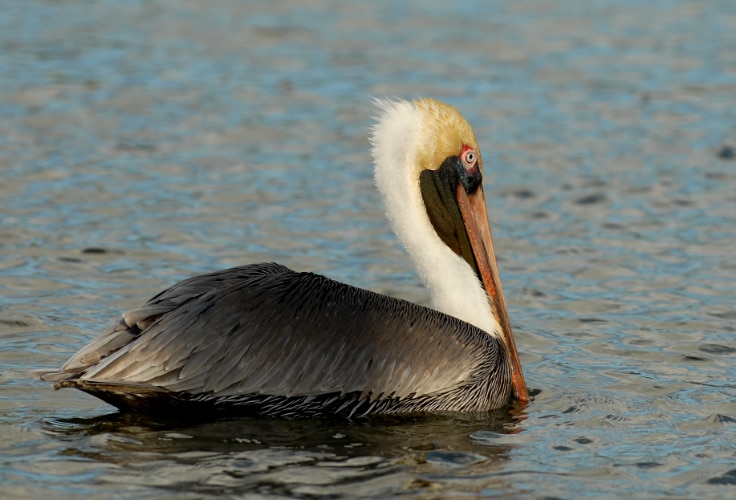
The brown pelican is one of North America’s most recognizable seabirds, famous for its dark plumage, massive bill, and spectacular plunge-diving behavior. Measuring 100-137 centimeters (39.4-54 inches) in length, it has long, bowed wings and a large gular pouch capable of holding several gallons of water. Adults are mostly gray-brown with pale yellow heads and white necks that turn rich chestnut during breeding. Despite their heavy appearance, these birds fly with remarkable grace, often gliding just above the ocean’s surface to ride the cushion of air created by the waves.
Brown pelicans are highly social and easy to recognize in the field. They typically travel in lines or V-shaped formations, alternating between slow wingbeats and effortless glides. Over the surf, they spot fish from the air and plunge headfirst from heights of up to 20 meters (65.6 feet), folding their wings just before impact. After surfacing, they drain water from their pouch before swallowing their catch. Their calls are limited to low grunts and croaks, most often heard around nesting sites. When resting, they loaf in flocks on sandbars, piers, or mangrove branches, often preening or engaging in short bouts of wing-stretching and bowing.
This species inhabits warm marine and estuarine coasts year-round, nesting on isolated islands and sandbars close to rich fishing grounds. It breeds along both the Pacific and Atlantic seaboards, from California and Maryland south through the Gulf of Mexico, Mexico, and into the Caribbean. Northern populations migrate short distances to warmer waters in winter, while tropical birds remain local. Nearly extirpated from parts of its range in the mid-20th century due to pesticide contamination, it has since made a full recovery following DDT bans and restoration programs. Today the brown pelican remains abundant and emblematic of healthy coastal ecosystems, though it continues to face risks from oil pollution, discarded fishing line, and human disturbance near nesting colonies.
Field Notes and Final Thoughts
From wetlands to open coastlines, these brown long-billed birds form one of the most diverse and adaptable groups in North America. Their colors may be subtle, but close observation reveals striking patterns, calls, and behaviors that set each species apart. Paying attention to bill shape, feeding style, and habitat is often the key to telling them apart in the field.

